English teachers often ask students to __________ a passage to get the gist of it. A.skim B.scan C.predict D.describe
题目
B.scan
C.predict
D.describe
相似考题
更多“English teachers often ask students to __________ a passage to get the gist of it. ”相关问题
-
第1题:
In English teaching, teachers should NOT pay attention to__________.A.providing independent learning and communicating opportunities for students
B.correcting students' mistakes and errors in the process of learning immediately
C.encouraging students to discuss, cooperate, experience, practice, and explore the way to master English
D.cultivating students' interest答案:B解析:考查英语教学方式。B项不正确,学习过程中不应马上纠正学生的错误。 -
第2题:
How should the teacher deal with students' writing errors?A.Teachers should limit students to take risks to use new vocabulary and structures.
B.Teachers should often show negative attitude towards students' writing errors.
C.Teachers should make corrections for all the writing errors of students.
D.Teachers should underline the errors and leave them for students to correct themselves.答案:D解析:考查写作教学。学生在写作中犯错常常是难以避免的情况.但是教师要不怕学生犯错并鼓励他们运用较难的词汇和句子,这样学生的写作能力才会提高,故A错误。教师如果经常对错误持消极的态度,就会阻碍学生的写作热情,不利于写作技能的提高,故B错。教师在批阅作文时,不应该自己把所有的错误都改正,而应该指出错误并让学生自己去改,以培养学生独立写作的能力,C项错误,故选D。 -
第3题:

二、考题解析
【教案】
Teaching aims:
Knowledge aim:
Students will master the expression of date and the sentence structure: -What is ...’s birthday? -It is ...
Ability aim:
Students will improve their abilities of speaking and listening.
Emotional aim:
Students will be more confident in speaking English.
Key and difficult point:
Key Point: Students will master how to express a date in English.
Difficult Point: Students will use the sentence structure in daily life.
Teaching procedure:
Step 1: Warming-up
1. Greetings.
2. Ask students if today is anyone’s birthday. And invite the whole class to sing a ‘Happy Birthday’ song to him or her.
Step 2: Pre-listening
1. Review the knowledge about ordinal numeral: write some numbers on the blackboard and ask students to change the cardinal numeral into ordinal numeral.
2. Ask students to look at the picture in the textbook to predict what the dialogue may be about.
Step 3: While-listening
1st listening: Ask students to listen to the tape for the first time and check if their prediction is correct or not.
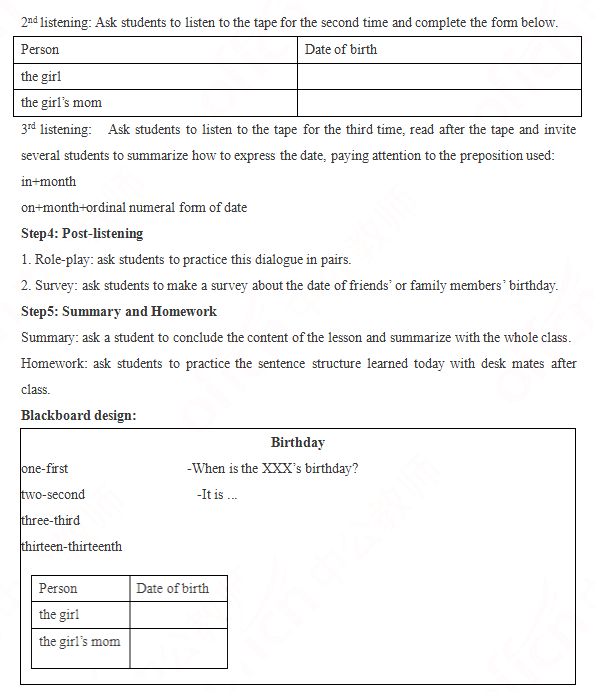
答案:解析:暂无解析 -
第4题:

二、考题解析
【教学设计】
Teaching aims:
Knowledge aims:
Students will know about the relation between shadow and the sun through reading the passage.
Students will master the usage of comparative degree in the reading.
Ability aim:
Students will apply the comparative degree to retell the story.
Emotional aim:
Students will be more interest in learning English.
Key and difficult point:
Key Point: Students will master the usage of comparative degree in the reading.
Difficult Point: Students will apply the comparative degree to retell the story.
Teaching procedure:
Step 1: Warming-up
1. Greetings.
2. Play a riddle--it rises up and goes down every day, what is it? and students guess it’s the sun, then lead to the story about the sun.
Step 2: Pre-reading
According to the word “sun”, students have a brainstorm about what natural phenomenon about sun they have known.
Step 3: While-reading
1. Fast reading: students read the passage fast and figure out what the tree and the duck are talking about.
2. Careful reading: students read the passage carefully and answer the question: why does the shadow get longer when the sun gets lower? And underline the words with “er”.
3. The teacher explains the words with “er” to the students.
Step4: Post-reading
1. Students work in pairs to make a role-play (one is the little duck, the other is the old tree) to make a conversation according to the passage.
2. Students work in groups to find the real reason why the shadow gets longer when the sun gets lower.
Step5: Summary and Homework
Summary: ask a student to conclude the content of the lesson and summarize with the whole class.
Homework: students tell the story to their parents.
Blackboard design:

1.Do you think repeated practice is suitable for English learning?
2.What do you think of English class activities such as role-play?答案:解析:1.
Reciting is a way of practicing. There is a gap between understanding English and using English. For students, even if they think they can remember what they learn in class, after class while applying the knowledge taught in class, it possibly doesn’t work very well. So it is a practice way but we can not only use it. We need to use more practice ways together reciting to ensure the effect of teaching and learning.
2.
English class activities play an important role in English teaching. These performances can stimulate students' interest in learning English, mobilize students' enthusiasm for learning English, activate classroom atmosphere, reduce students' learning pressure, help students overcome fear of English learning, cultivate students' participation awareness, cooperation spirit and leadership ability. -
第5题:
高中英语?阅读
一、考题回顾

二、考题解析
【教案】
Teaching aims:
Knowledge aim:
Students can know the basic meaning of passage and are able to master the different greeting for the strangers.
Ability aims:
Students can practice guessing content of next paragraph according to the clues which is given in the passage.
Emotional aim:
Students are able to love learning English and like to read different English passage after this lesson.
Key and difficult point:
Key Point: guess the content of next paragraph according to the clues and know the “learned” body language, especially different greetings
Difficult Point: improve students’ reading interest.
Teaching procedures:
Step 1: Warming-up
1. Greetings.
2. Play a video about Chaplin’s mime and ask students several questions:
What kind of body language can you see from this video?
Do you know the meaning of these body language?
Step 2: Pre-reading
Present the passage on the screen and read it for all the students. Before reading, ask students one question: What’s the main ideas of these two paragraphs? And guess the main to topic of this lesson?
Then invite several students to share their ideas.
Step 3: While-reading
1.Lead the students to think one question: Is this a whole passage? And ask students to scan the whole passage and give the teacher answer.
2.Ask students to discuss in group and after 10 minutes to invite several students to share their ideas with all the students.
3.And different students may be just guess the content of several paragraphs. So give students a chart, ask them to finish discussing in 5 minutes. Then invite two representatives to state the whole passage.

Step4: Post-reading
Guessing game: Present another passage on the screen. And give students 10 minutes to read and discuss.Then make a chart and tell your own stories according to chart in your own group .Then invite the representatives to make a report for the whole class.
Step5: Summary and Homework
Summary: ask a student to conclude the content of the lesson and summarize with the whole class.
Homework: Present a passage and ask students to read and write a short passsage,which will be put behind of last paragraph.
Blackboard design:

1.Do you have the experience in teaching?
2. What will you do if you pass this exam?答案:解析:1.
Yes, I do. I have taught a teenager in high school. She was the junior. I mainly taught her grammar. I found her grammar was not very systematic. So I taught her from the grammar in words to the grammar in sentences in order to make her master the whole grammar, especially those always appeared in her exams. And during the teaching, I find the most important that it is the teacher should have a better understanding of the whole grammar and the high school English course. Besides, the teacher should pay more attention to the patience. It will make students relax when their learning and get along with the students.
2.
First, I will find a teaching job to practice my teaching ability. And at the same time to prepare the teachers’ exams for school. When I prepare, I think the most important it’s to know the content of text in high school and do many exercises to practice these knowledge.
Second, I will visit some good teachers who is teaching the high school and learn some experience and practice my teaching ability.
Last, I need to reflect myself to improve my knowledge and my teaching procedures. -
第6题:

二、考题解析
【教案】
Teaching aims:
Knowledge aims:
Students will know how to describe a day using proper conjunctions and tense.
Students will master some words, such as waste, value... and a sentence structure: I usually + simple present tense.
Ability aim:
Students will improve their abilities of speaking and listening.
Emotional aim:
Students will be more confident in speaking English.
Key and difficult point:
Key Point: Students will know how to introduce a day in English.
Difficult Point: Students will use the sentence structure in real communicative situation.
Teaching procedure:
Step 1: Warming-up
1. Greetings.
2. Play a video about Tom’s day and ask students what kind of information have they caught.
Step 2: Pre-listening
1. Review the knowledge about simple present tense. Ask students to make sentences using simple present tense.
2.Using pictures to explain some words: waste-value, brush.
Step 3: While-listening
1st listening: Ask students to listen to the tape for the first time and try to get the main idea of the passage and underline the conjunctions used.
2nd listening: Ask students to listen to the tape for the second time and complete the timetable below.
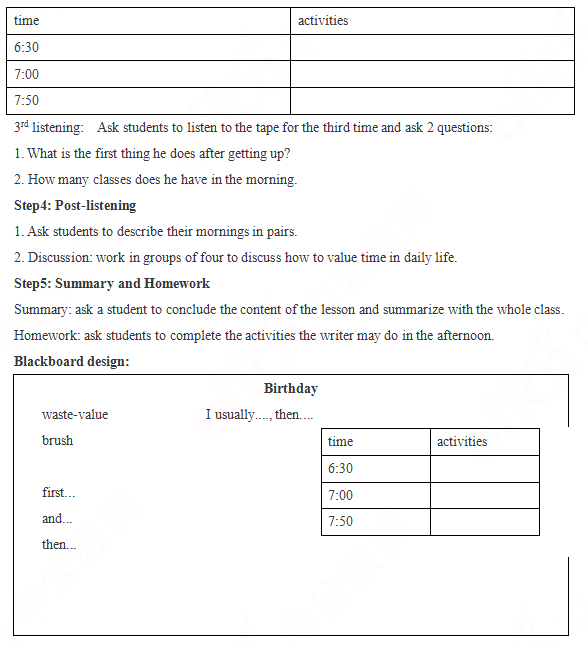 答案:解析:暂无解析
答案:解析:暂无解析 -
第7题:
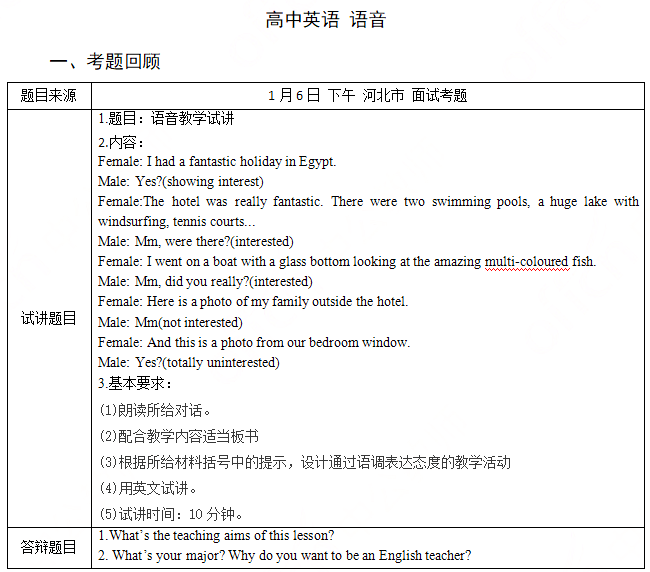
二、考题解析
【教案】
Teaching aims:
Knowledge aim:
Students can master the intonation of showing their attitudes.
Ability aim:
After this lesson, students can practice their listening and speaking ability through group work.
Emotional aim:
Students are able to love learning English after this lesson.
Key and difficult point:
Key Point: master the intonation of showing their attitudes.
Difficult Point: cultivate the interest of students’ learning English.
Teaching procedures:
Step 1: Warming-up
1. Greetings.
2. Play a video about a person who is shopping at a store and has a conversation with the shop assistant. And ask students to answer some questions: Does this customer want to buy the clothes? Give the reason
Step 2: Presentation
1.Ask students to listen the conversation carefully and the teacher reads the conversation that today needs to learn and ask students:
Which part does the male show the interest? Give the reason
And which part does the male show the uninterested? Give the reason
2.Then present the conversation on the PPT, and ask students to listen to the conversation again, pay attention to the intonation of male’s answers. And ask students to answer some questions:
When male shows the interest to the content of female’s saying, what kind of intonation does he use? Uninterested, what’s intonation?
3. Then lead the students to conclude the rules of intonations of showing their attitudes. At the same time, write the male’s words on the blackboard with the help of symbols of rising tone and falling tone.
Step 3: Practice
1.Ask students to read this conversation after the tape.
2.Role-play: Ask students to practice this conversation with their partner and after 5 minutes, invite some students to read this conversation for all the students.
3. Dubbing: Ask students to look at a short video about a conversation between a Chinese student and another foreign student. But this video only has the frames, but doesn’t have the sound, which needs students to finish dubbing with their deskmates in given 10 minutes. Then invite several students to show their conversation with all the students.
Step4: Production
Make stories: Ask students to use the knowledge of intonation to make a short story according to the chart. Before this, divide the students into several groups with different persons and ask the representatives to get their topic through the way of random draw.
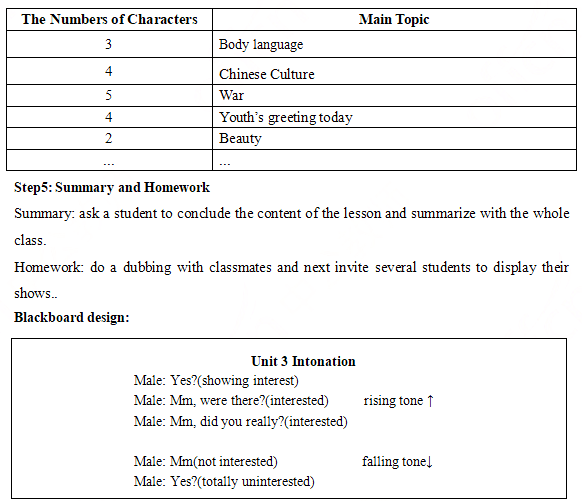
1.What’s the teaching aims of this lesson?
2. What’s your major? Why do you want to be an English teacher?答案:解析:1.
There are three aims: knowledge aim,ability aim and emotional aim.
Knowledge aim:
Students can master the intonation of showing their attitudes.
Ability aim:
After this lesson, students can practice their listening and speaking ability through group work.
Emotional aim:
Students are able to love learning English after this lesson.
2.
My major is medicine. But I like English. And my biggest hobby is learning and speaking English. In my daily life, I like to go abroad to travel and reading English novels. I think English is more useful and attracting for me than my major, medicine. -
第8题:
一、标题不可缺少
What are you doing?
二、教学目标撰写要以学生为主语
Teaching aims:
(1) Knowledge aims
Students can master the key sentence structure “what are you doing?” .
(2) Ability aims
Students can communicate with their partners by using the new sentence.
(3)Emotional aims
Students will be more interested in sharing their ideas with others and take part the group activity.
Teaching key point
Master the new sentence structure.
Teaching difficult point
Describe what other people are doing.
Teaching Methods:
Situational teaching method, task-based teaching method
Teaching Aids:
PPT
三、教学过程要完成清晰
Teaching procedure
Step 1 Warming-up
At the beginning of class, ask students a question about what do they usually do on weekend. Students may have different answer like go to the zoo, stay at home and so on. Then teacher ask: “do you want to know what others are doing now?” to lead to the topic today, and write it down on the blackboard.
(step can give students chances to speak English ,and get a good preparation for the next step—the presentation part, student’s interest will be aroused as they can share the things they know with others in English. It can also help nurture students’ confidence.)
Step 2 Pre-reading
Show the picture about the Larry’s home, letting students guessing what happened and predict the content about the reading material.
(Justification: guessing part will focus students’ attention on the main topic of the reading passage. It prepares students to think critically about the topic and provides them with the opportunity to connect some aspect of the topic to their own lives)
Step3while-reading
Fast-reading
Ask students to read the short passage quickly and conclude the main idea.
(Justification: train students’ reading ability of scanning for the general information of the passage.)
Careful reading
1.ask students to read the passage again and answer the following questions:
What is Larry doing?
What is dad doing?
What’s grandpa doing?
2. Ask students to finish the sentence on the textbook.
(Justification: in this part, students’ analyzing and summarizing ability can be trained. In the process of answering, students can get the detailed information, which can help students understand the sentence.)
Step4 post-reading
1.play the tape and ask students to read the short passage after the tape and pay attention to the pronunciation of the words and sentences.
2.let students do the group work, it is a role play, four in a group. One of them call another one and ask what he or she is doing. After that, volunteers can show their performance before the class.
(Justification: this part can activate the atmosphere of the class and arouse students’interest at the same time. It helps students strengthen what they have learned during this lesson.)
Step 5summary and homework
Summary: do the summary together with students and let them have a clear clue about what we have learned
Homework: try to use the new knowledge to communicate with their partners after class.
(Justification: summary and homework can help students consolidate the knowledge what they have learned in the class, the homework can train students ability )
四、板书设计不可少
Blackboard design:
What are you doing?
What is Larry doing?
What is dad doing?
What’s grandpa doing?答案:解析: -
第9题:
单选题In English teaching, teachers should NOT pay attention to ________.Aproviding independent learning and communicating opportunities for students
Bcorrecting students' mistakes and erors in the process of learning immediately
Cencouraging students to discuss, cooperate, experience, practice, and explore the way to master English
Dcultivating students' interest
正确答案: B解析: -
第10题:
问答题Directions:You are required to write a Notice in about 100 words to inform the students and English teachers of a lecture on American Liberal Education by Prof. Gilbert in the English Department Hall. Please write it on the Answer Sheet.正确答案:
NOTICE We are much honored to have Prof. Richard Gilbert from Harvard University to give us a lecture on American Liberal Education. Prof. Gilbert, who graduated from Stanford in 1979 and received his Ph.D. in Education from Harvard in 1984, has been conducting research and teaching international students in Harvard for more than 20 years. He has become a leading expert in this field and has published several books and numerous papers on liberal education and education policy. His humorous and thought provoking speech will surely benefit all the audience.
The lecture will be given in the English Department Conference Hall from 2:30 to 4:30. p.m., November 16, 2007. All the teachers and students are welcome.
English Department
(Word Count: 117)解析: 暂无解析 -
第11题:
单选题Which ofthe following strategies belongs to communication strategy?AWhen speaking English, the students can realize the mistakes and correct them.
BThe students often talk about their own feelings about learning with classmates and teachers.
CThe students communicate with others by using gestures and expressions.
DThe students use reference books to get more information.
正确答案: B解析: -
第12题:
单选题In writing,students may not know how to put something into proper English and thus ask their teacher for help.Here the teacher is to play the role of a/an .Afacilitator
Bassessor
Ccontroller
Dparticipant
正确答案: C解析: -
第13题:
Which of the following strategies belongs to commtmication strategy
A.When speaking English, the students can realize the mistakes and correct them.
B.The students often talk about their own feelings about learning with classmates and teachers.
C.The students communicate with others by using gestures and expressions.
D.The students use reference books to get more information.答案:C解析:考查对交际策略的理解。交际策略是学生为了争取更多的交际机会、维持交际以及提高交际效果而采取的行动。此题中,A项“当说英语时,学生能够意识到自己的错误并予以改正”,这属于认知策略。B项“学生经常与老师和同学交流学习体会”,这属于调控策略。C项“学生借助手势和表情进行交流”,这能够使交流更加顺畅.有利于表达自己的想法.同时也更有利于听话人的理解,属于交际策略。D项“学生利用参考书来获得更多的信息”,这属于资源策略。所以此题的正确选项为C。 -
第14题:
English teachers often ask students to__________ a passage to get the gist of it.A.skim
B.scan
C.predict
D.infer答案:A解析:考查英语阅读策。读(skim)和寻读(scan)都是快速阅读的方式,读的主要目的是获取文章的大意.寻读的目的是从文章中查寻特定的细节内容。 -
第15题:
初中英语?语法
一、考题回顾

二、考题解析
【教案】
Teaching aims:
Knowledge aim:
Students will know the usage of the frequency adverbs and the sentence structure “How often...?”.
Ability aim:
Students can use the sentence structure freely in their daily life.
Emotional aim:
Students will be more confident in learning English and not afraid of speaking English.
Key and difficult point:
Key Point: Students will know how to use the sentence structure in their daily life.
Difficult Point: Students can cultivate their confidence in learning English.
Teaching procedure:
Step 1: Warming-up
1. Greetings.
2. Ask students what they usually do in their spare time and why, and ask some of them to share with the whole class.
Step 2: Presentation
1. Listen to the tape for the first time and find out what the speaker does every day, and then invite students share their answers.
2. Ask students the following questions: how often does the speaker watch TV? How often does the speaker listen to music? And then write down the sentence on the blackboard.
3. Explain the sentence structure to students: the sentence structure is used to ask questions about how many times something has been done or how many times a state exists in a given period of time.
4. The teacher read the dialogue and ask students to read after it to get a deep understanding.
Step 3: Practice
1. Role-play. Ask students work in pairs and role play the dialogue. Then invite two groups to show in front of the class.
2. Play a game: word cards. Invite two couples of students. Ask one student to choose the card in the box and then ask the other students the question “ how often do you...?” using the activities showed in the card, and then change their role.
Step4: Production
Let students work in groups of 4 and discuss on the topic: how often do you...? according to their own hobbies. After that invite two groups to present in the whole class.
Step5: Summary and Homework
Summary: ask a student to conclude the content of the lesson and summarize with the whole class.
Homework: ask students to ask their friends “ how often do you...?” after class and write down on the exercise book.
Blackboard design:

1. Can you tell me the difference between “How often...?” and “How long...?”?
2. What do you usually do in your spare time?答案:解析:1.
The first sentence structure is used to ask questions about how many times something has been done or how many times a state exists in a given period of time. The second sentence structure includes two different usage: one is used to ask how long does it take. It's mainly used to ask questions for a period of time; the other is used to ask for the length of something.
2.
I really have a great passion for sports, i like to do yoga, cycling and jogging. Take jogging for example. It stimulates me to learn more about body -building. Secondly, I am able to meet new friends through my hobby. Lastly, the hobby will teach me some self-discipline, because to do it regularly is so challenging. -
第16题:
初中英语?阅读
一、考题回顾

二、考题解析
【教案】
Teaching aims:
Knowledge aim:
Students will grasp and understand the main and detailed information of the passage.
Ability aim:
Students will improve their reading and speaking skills.
Emotional aim:
Students will foster the interest and desire of learning English and take part in speaking activities actively.
Key and difficult point:
Key Point: Students will totally understand the content of the passage.
Difficult Point: Students will foster the interest of learning English, and take part in speaking activities.
Teaching procedure:
Step 1: Warming-up
1. Greetings.
2. Show students pictures about different types of transportation and naturally lead to today’s topic.
Step 2: Pre-reading
1. Ask students two questions and some volunteers will be invited to share their answers.
Q1: How do you come to school?
Q2: How do your parents go to work?
2. Ask students to predict the main idea of the passage based on the above discussion and pictures on the screen.
Step 3: While-reading
1st reading: Ask students to read the passage for the first time and check their prediction. Besides, they need to find out which countries are mentioned in the passage and circle them.
2nd reading: Ask students to read the passage for the second time and complete the following chart. Some students will be invited to finish it on the blackboard.

Step4: Post-reading
Discussion: ask students to discuss the advantages and disadvantages of different modes of transportation. Four students in a group, after five minutes, some groups are supposed to show their results.
Step5: Summary and Homework
Summary: ask a student to conclude the content of the lesson and summarize with the whole class.
Homework: ask students to investigate their friends’ way of going to school and find some interesting ways of transportation on the Internet.
Blackboard design:
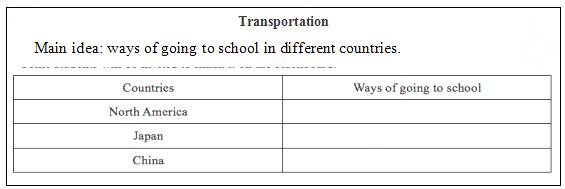
1. How to improve students’ reading and speaking ability in your class?
2. How did you evaluate the performance of students in the class?答案:解析:1.
It is very important to improve students’ reading and speaking abilities. In my class, I take three specific steps to improve their reading and speaking abilities. Firstly, before reading the article, I ask the students to guess the main idea of the article according to my questions and pictures on the screen. As you heard, this can not only exercise students’ guessing ability, but also help them read the passage with questions. In the while-reading part, I set two times of reading, namely extensive reading and intensive reading. Obviously, students’ scanning ability and the ability to grasp detailed information can be improved. It also helps them form good reading habits. As for speaking ability, I organize a discussion activity without standard answers. Students can express their views freely in groups. In this way, their reading and speaking abilities can be improved a lot.
2.
Students are under a stage of growing and developing. They are eager to be evaluated and encouraged by their teachers. At the same time, students are different, and their acceptance and abilities of learning are different. Therefore, in my class, I have adopted a variety of different evaluations. For the students who answered correctly, I would praise them directly, such as “excellent”, “you can find the answer so fast”. For those students who dare not answer questions or did not find out the answers, I just encouraged them and guided them to say the answers, and gave some encouraging comments, like “nice try!”, “you’ve made a great progress”. Also, some students made mistakes. In my class, instead of directly blaming the student for being wrong, I asked other students to help him/her and give them a proper evaluation. -
第17题:
初中英语?口语
一、考题回顾

二、考题解析
【教案】
Teaching aims:
Knowledge aim:
Students will know how to express their hobbies and interest.
Ability aim:
Students will improve their abilities of speaking and listening.
Emotional aim:
Students will be more confident in speaking English.
Key and difficult point:
Key Point: Students will know how to express their hobbies and interest in English.
Difficult Point: Students will be more confident in speaking English and not be afraid of speaking English in public.
Teaching procedure:
Step 1: Warming-up
1. Greetings.
2.Sing a song of Mick Jackson to lead in the lesson.
Step 2: Pre-speaking
Ask students to look at the picture of Paul Jackson and Beijing Opera to predict what we will learn today.
Step 3: While-speaking
1st listening: Ask students to listen to the tape for the first time and check if their prediction is correct or not and get the main idea of the passage.
2nd listening: Ask students to listen to the tape for the second time and tick and cross.
Mike’s favorite actor is Paul Jackson. ( )
Mike’s father often goes to see Beijing Opera on weekends.( )
Black September is a very successful thriller.( )
3rd listening: Ask students to listen to the tape for the third time, read after the tape and invite several students to summarize how to express hobbies.
Step4: Post-speaking
Ask students to have a discussion about their hobbies, four students in a group and give them 5 minutes.
Step5: Summary and Homework
Summary: ask a student to conclude the content of the lesson and summarize with the whole class.
Homework: ask students to introduce their favourite movies and share with their parents.
Blackboard design:

1.How to improve students’ speaking ability?
2.Do you think blackboard design is important?答案:解析:1.
The topic should be interesting, which can arouse the interest of students In the class, teachers should give students’ subjectivity to the full play and give them more chance to communicate with each other. And organize various activities to encourage them to express themselves.
2.
There is no doubt that blackboard design plays a very important role in teaching process. First, it should has title. Secondly, The key and difficult points should be prominent, which enables students to master the knowledge. What’s more, the blackboard design should be logic and clear. -
第18题:
初中英语?语音
一、考题回顾

二、考题解析
【教案】
Teaching aims:
Knowledge aim:
Students will know the rule of logical stress in a complete sentence.
Ability aim:
Students will use the logical stress correctly and know how to make use of the sentence stress in different sentences correctly.
Emotional aim:
Students will be more confident in speaking English.
Key and difficult point:
Key Point: Students will master the rule of logical stress in sentences in English.
Difficult Point: Students can use the logical stress in sentences in daily life.
Teaching procedure:
Step 1: Warming-up
1. Greetings.
2. Listen to an English song and feel about the tune of the melody. Let students to know that not only songs but also the language has its stress in order to express different emotions.
Step 2: Presentation
1. Work in pairs to read the passage by themselves and ask them to pay more attention to the sentence stress. After practice, ask one pair to perform it and others should tell their opinion whether they agree or not.
2. Listen to the tape of the passage and find out whether the students themselves make any mistakes. Then let students find out the rule of the sentence stress (logical stress ) with the help of the teacher: in a sentence we can stress the important part according to the meaning of the passage. After the students find the rule, the teacher read the passage and let them repeat after it.
Step 3: Practice
1. Ask students to read the passage by themselves again and they should use the correct logical stress while reading.
2. Give students more sentences and ask them read the sentences by themselves using the logical stress.
Step4: Production
Let students work in groups of 4 and make a dialogue about the theme parks, such as the theme, the feature, the activities and so on, and they should use the rule of logical stress learned in the class. After that invite two groups to share their outcomes with the whole class.
Step5: Summary and Homework
Summary: ask a student to conclude the content of the lesson and summarize with the whole class.
Homework: ask students to read the work of Shakespeare’s and use the logical stress learned today after class.
Blackboard design:
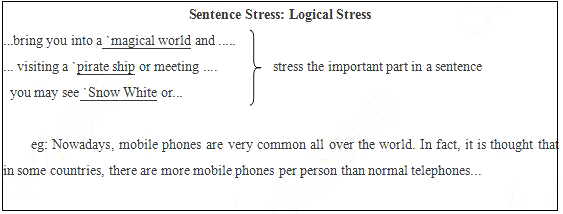
1. Can you conclude the rule of sentence stress comprehensively?
2. Are you satisfied with this presentation? Which do you think is the most difficult part?答案:解析:1.
As far as I’m concerned, there are two sentence stress rules: logical stress and grammatical stress. Logical stress is what i have presented in the presentation. The grammatical stress refers to that we need to stress notional word, which usually contains noun, verb, adjective adverb and so on. At the same time, the functional word needn’t to be stressed, which usually includes conjunction, article and preposition.
2.
The difficulty in my eyes is: first of all, without the participation of students, because of the teaching reasons, I can not interact effectively with students based on their feedback. In this case, it is difficult for me to organize classroom teaching activities and achieve the desired results. Second, what I need to improve is to introduce the key points to the students in a way that is easy to accept and adapt to the environment without an atmosphere of spoken English, because my spoken English is not very fluent, and I am very concerned about this interview. So I felt a little nervous. However, all these factors did not affect my overall performance. In view of the above problems, I will constantly reflect, and learn from experience in practice to improve my teaching ability. In short, I am basically satisfied with the presentation. -
第19题:
小学英语?阅读
一、考题回顾
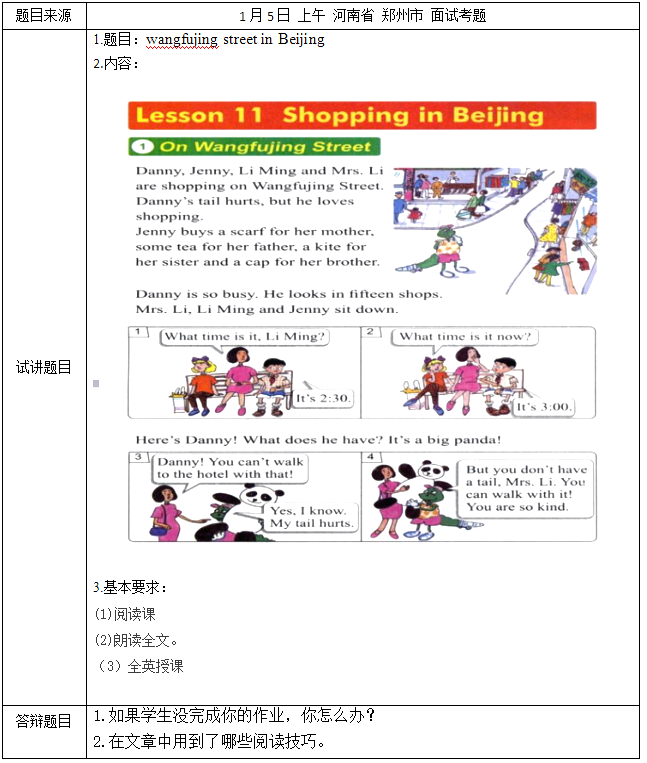
二、考题解析
【教案】
Teaching aims:
Knowledge aim:
Students can master the sentence :”what time is it? it is ..” and you can/ can not ...”
Ability aim:
Students can improve their reading skills including scanning and skimming skills
Emotional aim:
Students can be more interested in English and take part in activities.
Key and difficult point:
Key Point: know how to ask about the time and master the sentences::”what time is it? it is ..” and you can/ can not ...”
Difficult Point: use the sentence structure in daily life.
Teaching procedure:
Step 1: Warming-up
1. Greetings.
2. Ask students how did they spend their weekend.
3. Ask students “do you know wangfujing street in Beijing”
Step 2: Pre-reading
1. show a picture about wangfujing street and ask “what can you see in this picture”
2. draw a clock and ask students “Do you know how to ask about time?” and “what can you do at this time?
Step 3: While-reading
Global reading: Ask students :”how many characters in the dialogue?” and “where are they”
Detailed reading: what does Jenny buy and who will get the gift?
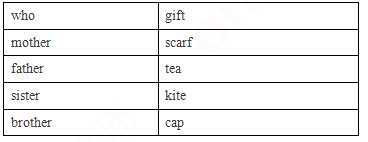
Step4: Post-reading
1. Role-play: two students in a group. One student act as traveller and one student is tour guide. Give them 5 minutes to make dialogue with what we have learnt today.
Step5: Summary and Homework
Summary: ask a student to conclude the content of the lesson and summarize with the whole class.
Homework: ask students to practice the sentence structure learned today with desk mates after class.
Blackboard design:
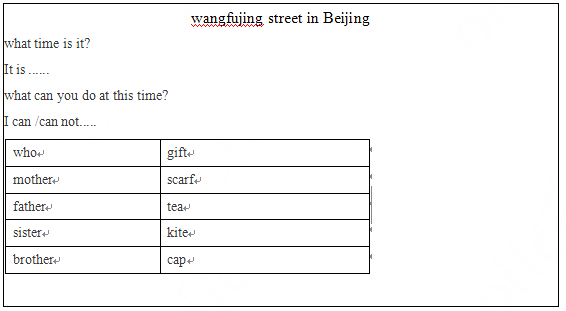
1. What will you do if the students don't finish your homework?
2. What reading skills are used in the passage?答案:解析:1.
Homework is an important means to show students' intelligence and improve their quality. Doing homework is the summary and consolidation of the knowledge learned, so doing homework is one of the important means for students to master knowledge.Third, fourth grade students such as not to assign homework is not conducive to the timely review of students to consolidate the knowledge, is not conducive to students to develop good learning habits. Therefore, how to help students homework on time with high quality is the primary task of every teacher.
firstly, I will talk to students to analyze the reason why he did not finish the homework. The reason maybe as follows: He dose not how to do it without any help. or he thinks homework is so much and can not finish it and so on. Then I will take action according to the reasons.
2.
In order to make students be more interested in reading and can understand the knowledge clearly, I use detailed reading to make students find the detail information and global reading to find the how many characters in the dialogue. In the reading passage. students can master and scanning skills and skimming skills. They can understand the passage step by step. -
第20题:
初中英语?阅读
一、考题回顾
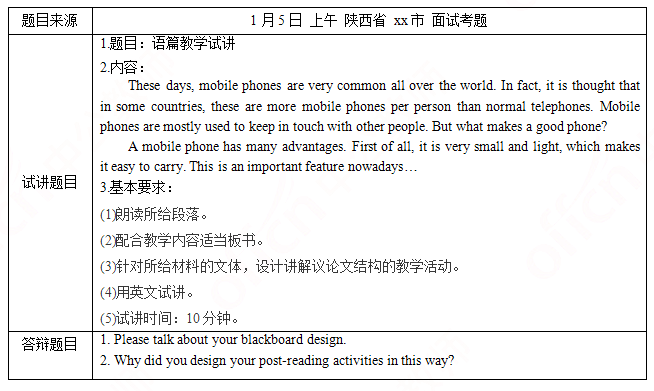
二、考题解析
【教案】
Teaching aims:
Knowledge aim:
Students will master the basic format of argumentation and get the general idea of the passage.
Ability aim:
Students will write argumentation to express their views on different issues.
Emotional aim:
Students will be interested in learning English and are no longer afraid of writing in English.
Key and difficult point:
Key Point: Students will master how to write an argumentation.
Difficult Point: Students will express their opinions in daily life through argumentative essays.
Teaching procedure:
Step 1: Warming-up
1. Greetings.
2. Show students different types of mobile phones and ask them to discuss similarities and differences.
Step 2: Pre-reading
Ask students two questions and some volunteers will be invited to share their answers.
Q1: Do you have a mobile phone? Are you satisfied with it?
Q2: What is the most important factor when you choose your mobile phone?
Step 3: While-reading
1st reading: Ask students to read the passage for the first time and figure out the main idea and genre of the passage.
2nd reading: Ask students to read the passage for the second time and pay attention to the structure of the passage. Some students will be invited to try to summarize the format of the argumentation.
Step4: Post-reading
1. Discussion: Four students in a group, ask them to discuss the advantages and disadvantages of mobile phones for junior high school students.
2. Outlining: Ask students to write an outline based on their opinions about the influence of mobile phones for junior high school students.
Step5: Summary and Homework
Summary: ask a student to conclude the content of the lesson and summarize with the whole class.
Homework: ask students to revise their outline and complete their composition after class.
Blackboard design:

1. Please talk about your blackboard.
2. Why did you design your post-reading activities in this way?答案:解析:1.
Thanks for your question. As we all know, blackboard design is very important for teaching. Firstly, it can help teacher present the teaching content. Students can understand the main content of the lesson easily. Secondly, it helps students to break through teaching key and difficult points. Students can have enough time to think and observe the knowledge. Thirdly, it helps student to take notes and develop good writing habits. Based on these functions, my blackboard design can be divided into three parts. The title is very simple and clear. And then is the main topic of the passage, students can easily understand the task of today’s lesson. The last part is the key point of the lesson. I present the basic format of argumentation, which takes more time in class. By doing so, students can easily master the argumentation format and write their own outline according to it.
2.
Thanks for your question. The purpose of language learning is to communicate. In my opinion, there are only two ways to communicate, that is, speaking and writing. In this class, I designed it as a reading lesson. After reading the article, students had a good understanding of the topic and the basic format of the article. So I designed a discussion first. Students could express their views freely on the topic. Of course, the format of argumentation was taught in class, so students were supposed to practice it. So I organized the second activity, that is, wrote an outline. Students could write their own outlines according to what they have discussed before. In this way, the input and output of this lesson will be more reasonable and diverse. -
第21题:
单选题In English teaching,teachers should NOT pay attention to_______.Aproviding independent learning and communicating opportunities for students
Bcorrecting students'mistakes and errors in the process of learning immediately
Cencouraging students to discuss,cooperate,experience,practice,and explore the way to master English
Dcultivating students'interest
正确答案: A解析: -
第22题:
单选题When asking students to quickly run their eyes over a whole text to get the gist, we are training their skill of__________.Ascanning
Bmapping
Cpredicting
Dskimming
正确答案: C解析: -
第23题:
单选题English teachers often ask students to_____ a passage to get the gist of it.Askim
Bscan
Cpredict
Dinfer
正确答案: A解析:
